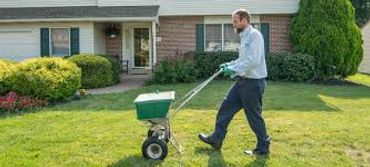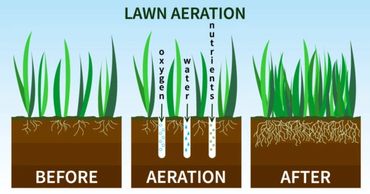Lawn Treatments

Why
Weeds, bugs, disease, foot traffic, and grass’s biological need for nutrients and water make it impossible to grow lush, healthy lawns without consistent lawn treatments.
Lawn fertilization strengthens grass and its root system, making your lawn less vulnerable to disease and more resistant to pests. Fertilizer ensures nutrients are evenly distributed across your lawn, improving grass growth and protecting soil from the stress of environmental factors like rain and drought.
Weeds grow quickly and absorb nutrients as they do, making it more difficult for grass roots to thrive. Weed control not only makes your lawn look better, but it also makes it easier for grass to access the elements it needs to survive and thrive, like potassium, nitrogen, and phosphorus.
Combining these practices at the appropriate times of year prevents these challenges from killing grass or stunting its growth.

For your lawn’s optimal health and beauty, we highly recommend the following treatment schedule.
- · Spring Lawn Application
Slow-Release Fertilizer / Pre-Emergent for Crab Grass
- · Early Summer Lawn Application
Slow-Release Fertilizer / Pre and Post Emergent for Crab Grass
- · Fungicide Application
- · Summer Lawn Application
Slow-Release Fertilizer / Weed Control
- · Grub Control
- · Fall Lawn Application
Slow-Release Fertilizer / Broadleaf Weed Control
- 2nd Fungicide Application
Other Services Offered
Winterizer
Winterizing your lawn helps prevent snow mold, helps keep your lawn green through the cold months, and gives your lawn an early start to healthy and green growth in the spring by storing nutrients in the roots during the dormant months.
Lime Treatment
Applications of lime are needed to increase the pH level of your lawn. The pH level is directly related to the amount of soil nutrients available to your grass plants in your lawn. Lime can regulate soil acidity and increase the effect of lawn fertilizer. Lime is applied in the Spring or Fall.
Aeration
Compacted soil and heavy thatch are the two biggest obstacles to a beautiful lawn. They can prevent air, water and nutrients from reaching the root zone. Aeration opens up the thatch and helps your lawn breathe. It should be done annually in the early spring or fall.
Over Seeding
Overseeding with a PennState mix of part Fescue, part Kentucky Blue and a part perennial rye grass helps keep your lawn healthy and durable by introducing new and stronger varieties of grass. Fall is the best time to overseed, since the weather is cooler and we have more moisture.
Fungicide
Prevents the growth of fungi and their spores, including rusts, mildews and blights.
Add a footnote if this applies to your business
Photo Gallery






Copyright © 2024 Schlegel Lawn & Landscaping LLC. - All Rights Reserved.
Powered by GoDaddy